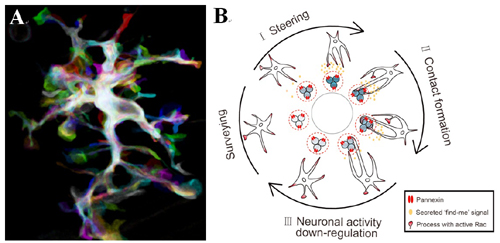Time:2012-11-30
On Nov. 29th, 2012, Dr. Jiulin Du’s research group at the Institute of Neuroscience, Chinese Academy of Sciences, published online a research article entitled “Reciprocal Regulation between Resting Microglial Dynamics and Neuronal Activity In Vivo” in Developmental Cell. This work was carried out by graduate students Ying Li and Xu-fei Du, under the supervision of Dr. Jiu-lin Du.
Microglia are the primary immune cells in the brain. Under pathological conditions, they become activated and participate in scavenging, inflammation and tissue repair in response to brain injury. The functions and underlying mechanisms of activated microglia have been intensively studied and are well understood. Under physiological conditions, microglia typically stay in a “resting” state most of the time, with highly branched processes continuously extending to and retracting from surrounding brain tissues on a time scale of minutes. Whether and how such highly dynamic resting microglia functionally interact with neurons remain to be elucidated.
In this study, the authors simultaneously monitored both the motility of resting microglial processes and the activity of surrounding neurons in intact zebrafish optic tectum, and examined the interaction between them. Using in vivo time-lapse imaging, they first monitored changes in the morphology and motility of resting microglia in response to local elevation of neuronal activity by glutamate uncaging or to global alteration of neuronal activity by visual stimulation and pharmacological manipulations. They found that locally elevated neuronal activity steered resting microglial processes towards the soma of highly active neurons and facilitated the formation of microglia-neuron contact. This process requires the activation of pannexin-1 hemichannels in neurons and of small Rho GTPase Rac in resting microglia. Interestingly, they found that such microglia-neuron contact in turn down-regulated both spontaneous and visually evoked activities in the contacted neuron.
This work reveals an instructive role of neuronal activity in resting microglial motility and suggests a novel function of microglia in homeostatic regulation of neuronal activity in the healthy brain. Considering the bidirectional modulation between neuron and microglia, this study also represents a new perspective on neural-immune interactions.
This work was supported by the grants from Ministry of Science and Technology of China, Chinese Academy of Sciences, and Shanghai Municipal Government.

A.Overlay of projected images of a resting microglial cell acquired every 5 min for an hour during in vivo time-lapse confocal imaging of the optic tectum in a 6-dpf Tg(Apo-E:eGFP) zebrafish larva.
B.Working model for the bidirectional modulation between resting microglia and neuron.
 附件下载:
附件下载: